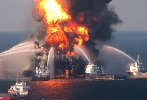
BP Wins Four Deepwater Exploration Blocks Off South Australia's Coast
The company does not expect to begin drilling until 2013 or 2014. It promised "to use the intervening time to fully implement the lessons learned from the investigations into the Montara and Deepwater Horizon incidents."
BP has won permission from Australia's government to explore for oil and gas in four deepwater blocks off the coast of South Australia. The four blocks are a promising area of 24,000 square kilometers for oil and gas reserves, according to company officials, with Mike Daly, executive vice president of exploration, saying in BP's Jan. 17 announcement, "This is a material and early move into an unexplored deepwater basin."
"Seismic survey activity could take place in the summer of 2011/12. Drilling activity is not expected to take place until 2013 or 2014. BP is committed to use the intervening time to fully implement the lessons learned from the investigations into the Montara and Deepwater Horizon incidents, and is working closely with the Australian Government, the South Australian Government and industry to do so," the announcement states.
Americans unfamiliar with the Montara incident will find parallels to the Deepwater Horizon disaster. Montara was an Aug. 21, 2009, well blowout in the Timor Sea from a platform drill rig owned by PTTEP Australasia; the spill of oil and gas was stopped on Nov. 3, 2009. A final report issued Nov. 24, 2010, by a commission of inquiry concluded there were systemic safety failures by PTTEP that allowed the spill to occur, and a single authority should be created to regulate offshore energy operations.
"The fact is that we were lucky with Montara –- no lives were lost, there were no serious injuries and the quick, coordinated response from governments, regulators, and industry meant that the impact on the marine environment was minimal," Martin Ferguson, minister for Resources and Energy, said when the report was issued. "Montara was the first major loss of well control in 25 years of safe offshore petroleum operations. If either -- or preferably both -– PTTEP AA or the Northern Territory Designated Authority had done their jobs properly and complied with requirements, the Montara Blowout would never have happened."
The presidential commission created by President Obama to investigate the Deepwater Horizon explosion and fire, its sinking, and oil spill issued its final, 398-page report last week, citing errors by the three main actors involved and saying the explosive loss of the Macondo well could have been prevented, then states this conclusion: "The immediate causes of the Macondo well blowout can be traced to a series of identifiable mistakes made by BP, Halliburton, and Transocean that reveal such systematic failures in risk management that they place in doubt the safety culture of the entire industry."
The panel called for reforming the government's oversight of offshore leasing, energy exploration, and production beyond what has already been announced as a result of the disaster. "Because regulatory oversight alone will not be sufficient to ensure adequate safety," they wrote, "the oil and gas industry will need to take its own, unilateral steps to increase dramatically safety throughout the industry, including self-policing mechanisms that supplement governmental enforcement. The technology, laws and regulations, and practices for containing, responding to, and cleaning up spills lag behind the real risks associated with deepwater drilling into large, high-pressure reservoirs of oil and gas located far offshore and thousands of feet below the ocean’s surface. Government must close the existing gap and industry must support rather than resist that effort."
Neither the energy industry nor the government has been adequately prepared for the risks involved in deepwater production and exploration, the panel concluded, adding that both "can and must be prepared in the future."